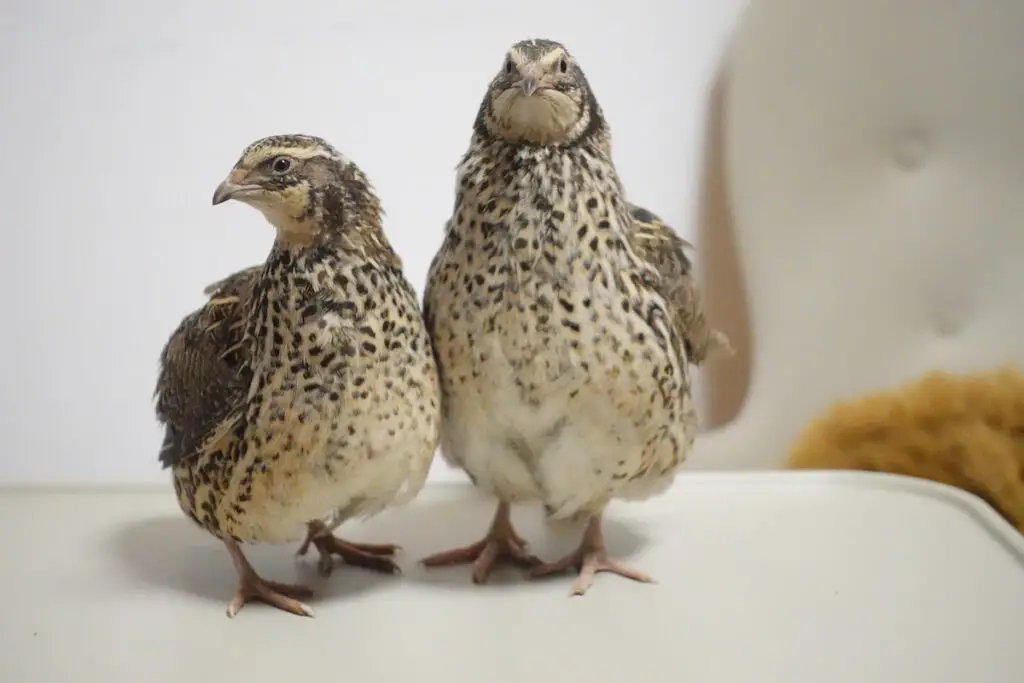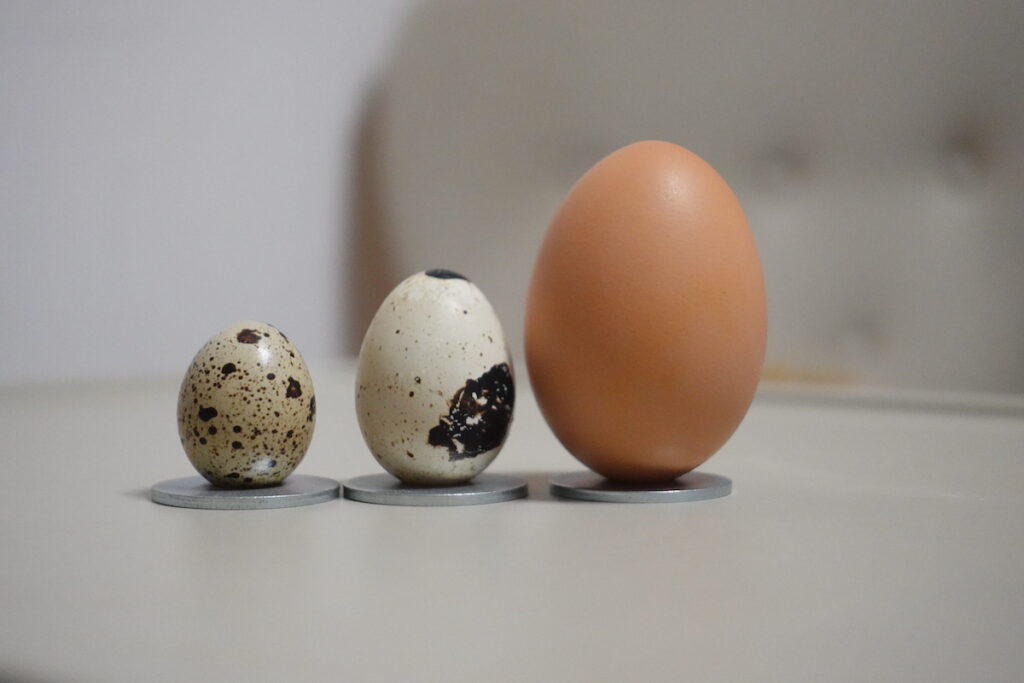Jumbo quail and standard quail are different varieties of the same species of small birds that can be reared on a home farm. They both provide a source of nutritious eggs and tasty meat. If you are considering which type to choose and are not sure, knowing the differences between the two will help you decide and allow you to breed happy healthy quail.
The main difference between jumbo and regular quail is their size and the size of their eggs. Jumbos are larger, eat more and require more space. They are often raised for their tender and flavorful meat. Regular quail are usually raised for their eggs which are smaller but more numerous.
Let’s dive in and look more closely at the differences you need to consider when it comes to jumbo quail vs regular quail.
Jumbo Vs. regular quail: size
The word jumbo gives a clue – these birds are significantly larger than regular or standard quail. The size of a quail can be determined by its weight at around ten weeks old. If the quail weighs a minimum of 10 oz at this age, it can be considered a jumbo. A regular adult quail weighs around 5 to 8 oz, while an adult jumbo will weigh around 14 to 15 oz.
Learn how to raise your own quail and have an unlimited supply of eggs and meat.
If you are breeding quail for meat, you will get more meat from a jumbo.

Standard quail have less meat on them. After skinning and dressing for roasting, a standard quail will provide around 3-5 oz. For a meal, an adult will need to eat more than one quail.
Jumbo quail will weigh around 8 to 10 oz after skinning and dressing for roasting. A jumbo quail can feed one adult.

Due to their larger size, many farmers prefer to breed jumbo quail for their meat. I find that jumbo quail meat is slightly more tender and flavorful than standard quail meat, but your preferences may vary.
Jumbo Vs. regular quail: egg size
As one would expect, a smaller bird lays small eggs! My regular quail lay 10-12 gram eggs, and my jumbo quail lay 12-15 gram eggs. Standard quail eggs are about 1.1 inches to 1.5 inches in size. Compared to a chicken egg, they are about 1/3 of the size. Jumbo eggs are about the size of a bantam chicken egg.

If you are packing your eggs to sell, regular quail eggs must be packed into special little quail egg cartons that have small cups to hold the eggs. Don’t pack your small quail eggs into regular egg boxes; they will roll around and break. Jumbo eggs are a little bit special because they are often too large for the quail egg cartons, but too small for the chicken egg cartons.
I managed to source some quail egg boxes that are the perfect size for jumbo eggs.
Regular quail eggs are small and difficult to work with. They cannot be cracked on the side of a bowl as you would do with a chicken egg. You can purchase special scissors for dealing with quail eggs which will make your life much easier. Jumbo eggs are easier to handle, albeit still a bit fiddly and these scissors come in handy.

Although the eggs are different in size, both types look similar. Unlike chicken eggs which have a plain off-white shell, quail eggs are speckled and often have lovely colors.
Jumbo Vs. regular quail: egg production
Regular quail are typically raised for their eggs, which are smaller but more numerous than jumbo quail eggs. My regular quail lay about 290-310 eggs a year. My jumbos lay fewer at around 270 eggs per year. It’s not a huge difference but something to keep in mind.
Since this difference is over the course of a year, you will not notice a huge drop in egg-production for a full month, but rather, it means that there are some days that your jumbo won’t lay an egg. If you keep 100 birds, you may get 90 eggs from your regular quail, and only 85 from your jumbos.
The difference in egg production could be due to the larger size of the jumbos. As they need more energy to maintain their body weight, they may divert energy towards growth and muscle development rather than egg production.
Jumbo Vs. regular quail: feeding
My fully grown regular quail eat around 1.5 oz of feed per day, and my jumbo quail eat around 2 oz of feed per day. This has an impact on the cost of the feed. In the second month, when the quail have reached adult size, my costs average around $1.12 per month for regular quail and $1.50 per month for my jumbos.
It costs more to raise jumbo quail, but the difference can be offset by the size of the eggs and the amount of meat they produce.
In this article I break down the cost of feeding quail and I go into detail in jumbo quail and regular quail as well. It’s important to know what you can expect before you purchase your quail so you can get started the right way.
Both jumbo quail and standard quail can be fed various commercial feeds, including pelleted or crumbled feeds. Jumbos typically require a higher protein feed for longer than regular birds. This is because they grow larger and require more energy. What this means in practice is that you should keep them on the starter feed a few days or weeks longer so they can develop. While you may cut down on protein and ramp up calcium for standard birds at around 8 weeks, you will probably only do this after 10 weeks for jumbos.
Jumbo quail also benefit from feed that has a higher calcium component in general, as they produce larger eggs. Quail that don’t get enough calcium will produce eggs with shells that are thin, weak, and irregularly shaped. You can supplement your jumbo quail diet with crushed oyster shells or ground limestone. Both offer a high content of calcium.
Jumbo Vs. regular quail: housing requirements
Jumbo quail need slightly more space because of their larger size. Even though there’s no exact number to follow, I like going with the recommendation of Zach from My Shire Farm of 3.5 regular quail per sq ft or 3 jumbo quail per sq ft. This is the maximum number of birds I will ever put in a cage.
This may sound like a small difference, but your jumbo quail will feel far more comfortable, especially when you have larger flocks. Quail kept in restricted and overly crowded spaces become stressed, and stressed birds don’t lay eggs like happy birds.
Sometimes I have way fewer birds in the cage than the maximum number allowed. In this case, I pay close attention to how I introduce new birds to the covey so my existing birds don’t get too territorial.
Can you keep jumbos and regular quail together?
You can keep regular and jumbo quail together in the same coop. Be careful how you introduce them to each other. Take time and observe them carefully. If your birds appear to be stressed or get agitated, then separate them for a while. You can even cross-breed my standard and jumbo quail because they are the same species but only different in size.
I like keeping my jumbo and regular quail separately. This way, I know that incubating eggs from the jumbo quail will result in large size birds.
What do jumbo and regular quail have in common?
Jumbo quail and regular quail are very similar. Both types are easy to raise. They are happy in a clean coop with fresh food and water and will lay eggs regularly if they get more than 14 hours of light per day. Quail are not noisy and won’t fly away. If you offer them a well-balanced diet, both regular and jumbo quail will produce nutritious eggs and very tasty meat for home consumption or to provide an income for a small business.
Final thoughts
Both jumbo quail and regular quail can be bred successfully on a backyard farm. There are some differences in their requirements due to their differing sizes and growth rates. It is important to ensure that jumbo quail have more space per quail in your coops. They also eat more and require feed with higher calcium levels as they produce larger eggs. If you want to keep both types, with some care and planning, they can live in the same housing.
By following these simple guidelines, your will ensure that your regular and jumbo quail will live happily and provide an ongoing source of eggs and meat.
Happy Quailing!

